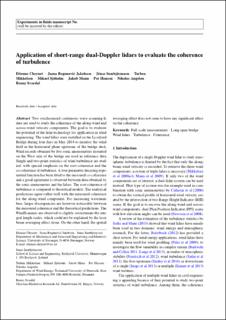| dc.contributor.author | Cheynet, Etienne Francois Cyprien | |
| dc.contributor.author | Jakobsen, Jasna Bogunovic | |
| dc.contributor.author | Snæbjörnsson, Jonas Thor | |
| dc.contributor.author | Mikkelsen, Torben | |
| dc.contributor.author | Sjöholm, Mikael | |
| dc.contributor.author | Mann, Jakob | |
| dc.contributor.author | Hansen, Per | |
| dc.contributor.author | Angelou, Nikolas | |
| dc.contributor.author | Svardal, Benny | |
| dc.date.accessioned | 2023-01-10T07:02:06Z | |
| dc.date.available | 2023-01-10T07:02:06Z | |
| dc.date.created | 2016-11-16T09:36:27Z | |
| dc.date.issued | 2016 | |
| dc.identifier.citation | Cheynet, E., Jakobsen, J. B., Snæbjörnsson, J., Mikkelsen, T., Sjöholm, M., Mann, J., ... & Svardal, B. (2016). Application of short-range dual-Doppler lidars to evaluate the coherence of turbulence. Experiments in Fluids, 57(12), 1-17. | en_US |
| dc.identifier.issn | 0723-4864 | |
| dc.identifier.uri | https://hdl.handle.net/11250/3042124 | |
| dc.description.abstract | Two synchronized continuous wave scanning lidars are used to study the coherence of the along-wind and across-wind velocity components. The goal is to evaluate the potential of the lidar technology for application in wind engineering. The wind lidars were installed on the Lysefjord Bridge during four days in May 2014 to monitor the wind field in the horizontal plane upstream of the bridge deck. Wind records obtained by five sonic anemometers mounted on the West side of the bridge are used as reference data. Single- and two-point statistics of wind turbulence are studied, with special emphasis on the root-coherence and the co-coherence of turbulence. A four-parameter decaying exponential function has been fitted to the measured co-coherence, and a good agreement is observed between data obtained by the sonic anemometers and the lidars. The root-coherence of turbulence is compared to theoretical models. The analytical predictions agree rather well with the measured coherence for the along-wind component. For increasing wavenumbers, larger discrepancies are, however, noticeable between the measured coherence and the theoretical predictions. The WindScanners are observed to slightly overestimate the integral length scales, which could not be explained by the laser beam averaging effect alone. On the other hand, the spatial averaging effect does not seem to have any significant effect on the coherence. | en_US |
| dc.language.iso | eng | en_US |
| dc.publisher | Springer | en_US |
| dc.title | Application of short-range dual-Doppler lidars to evaluate the coherence of turbulence | en_US |
| dc.type | Peer reviewed | en_US |
| dc.type | Journal article | en_US |
| dc.description.version | acceptedVersion | en_US |
| dc.rights.holder | Springer | en_US |
| dc.subject.nsi | VDP::Teknologi: 500 | en_US |
| dc.source.pagenumber | 17 | en_US |
| dc.source.volume | 57 | en_US |
| dc.source.journal | Experiments in Fluids | en_US |
| dc.source.issue | 12 | en_US |
| dc.identifier.doi | 10.1007/s00348-016-2275-9 | |
| dc.identifier.cristin | 1400876 | |
| dc.relation.project | Norges forskningsråd: 193821 | en_US |
| cristin.unitcode | 217,8,5,0 | |
| cristin.unitname | Institutt for maskin, bygg og materialteknologi | |
| cristin.ispublished | true | |
| cristin.fulltext | postprint | |
| cristin.qualitycode | 1 | |
